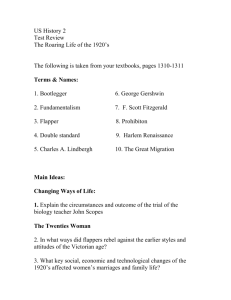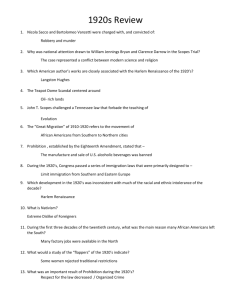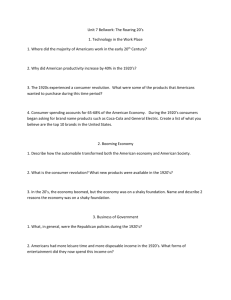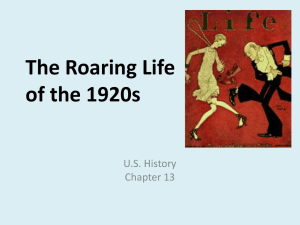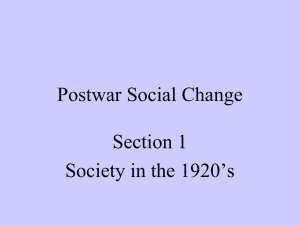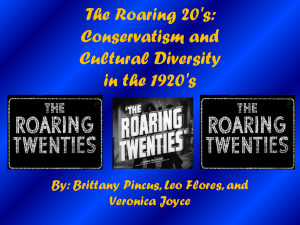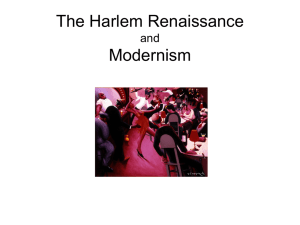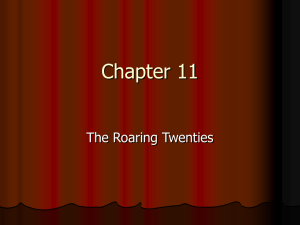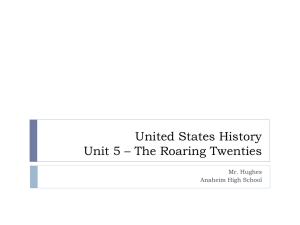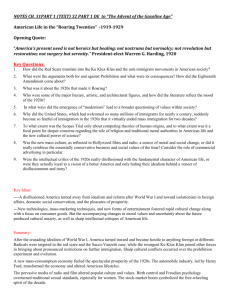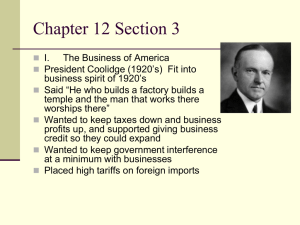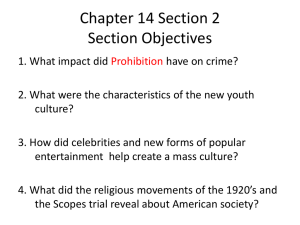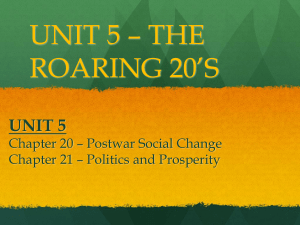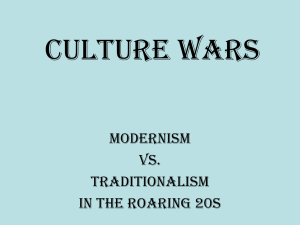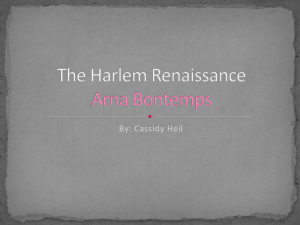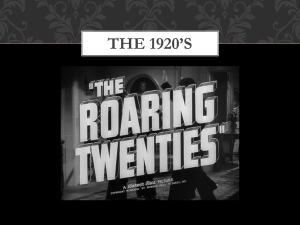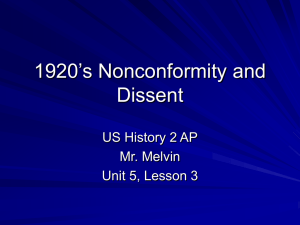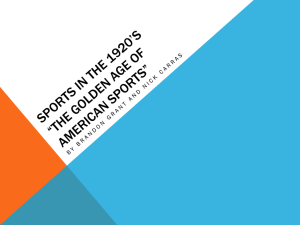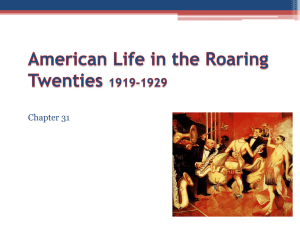Roaring 1920`s
advertisement
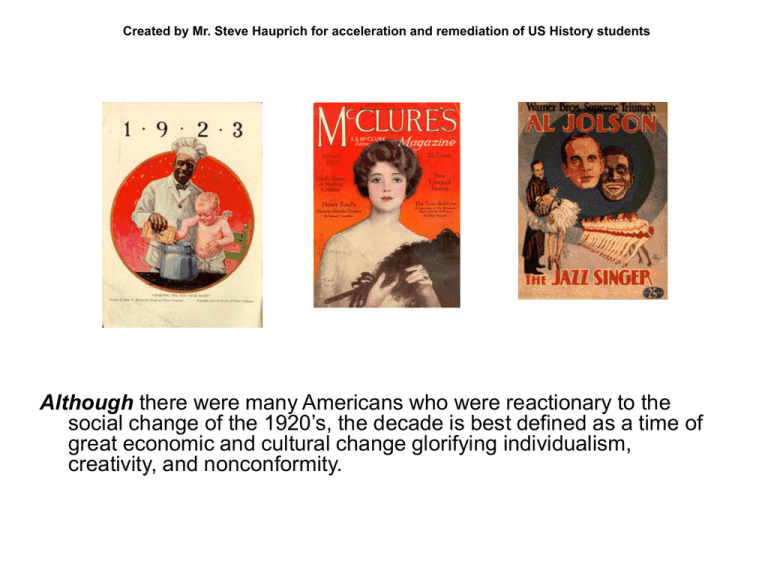
Created by Mr. Steve Hauprich for acceleration and remediation of US History students Although there were many Americans who were reactionary to the social change of the 1920’s, the decade is best defined as a time of great economic and cultural change glorifying individualism, creativity, and nonconformity. Because smiles are the weak days! He was weak s In a very different venue, Marx Brothers’ movies were zany, including slapstick antics and jokes about human indecency. Performing families like the Marx Bros and Howard Brothers (Curly, Larry, Moe) were generally recognized as non-conformists who did not mix well with the upper crust, hoi polloi, or the very articulate. Babe Ruth probably never lied under oath, but he was controversial as he promoted fast living and limited self-control. Lucky Lindberg flew a non-stop solo trans-Atlantic flight that earned him a ticker-tape parade in NY City. There was little speculation at the time that he may have cheated other than a catnap. Gertrude “Trudy” Ederle swam the English Channel in the 1920’s, breaking the men’s record by 2 hours. Her individual accomplishment made many Americans proud of her. Newspaper headlines included stories of criminal trials for Sacco and Venzetti, Leopold and Loeb, and other sensational events. Clara Bow was the “It” girl of the 1920’s. Young women wanted to capture her look, and America was learning about cosmetics. More than ever before, Americans were becoming very conscious of their appearance relative to what they were seeing in movies and advertisements. Flapper women were modernists who dressed with less than one pound of clothing whenever possible. They bobbed they hair short and went through extreme makeovers to anger their parents. Flappers wore less clothing, however young men in the 1920’s began to wear over-sized pants. This trend would not reappear again until the late 20th century, inspired by hip-hop culture, antidisestablishmentarianism, and the Freudian Id. The epitome of style was the cloche hat and driving your own car. Flappers had a great sense of style and were looking for attention. Being labeled a wallflower or participating in a Sadie Hawkins dance would be un-flapper-like…but dancing the Charleston… Dancing the Charleston was a very young and crazy thing to do ! So were dance marathons, homecoming bonfires, and mosh pits. Flappers typified the modernist view of the Roaring Twenties as the Jazz Age… fast paced change, new trends, new ideas… The Harlem Renaissance was an outpouring of artistic creativity. African American women authors and painters gained recognition. Jazz performers like Louie Armstrong, Bessie Smith, and Duke Ellington were heard on records, radio stations, and in the movies. Langston Hughes was a great poet of the Harlem Renaissance. He is considered one the best American authors of the 20th century. I, too, sing America. I am the darker brother. They send me to eat in the kitchen When company comes, But I laugh, And eat well, And grow strong. Tomorrow, I'll be at the table When company comes. Nobody'll dare Say to me, "Eat in the kitchen," Then. Besides, They'll see how beautiful I am And be ashamed-I, too, am America. Langston Hughes While not part of the Harlem Renaissance, novelists like F.Scott Fitzgerald and Sinclair Lewis won wide acclaim for their criticism of an overly conforming and materialistic US society. Although there were new ideas in art, music, and literature, there was a strong undercurrent of resistance to modern thinking, as religious fundamentalists joined reactionaries to confront social concerns. The Scopes Trial was a victory for the opponents of Darwinian evolutionary theory. Religious fundamentalists would postpone the teaching of evolution in public schools in Tennessee until 1967. KKK membership rose to over 4 million in the 1920’s and staged a demonstration march of 40,000 members in Washington DC. The KKK phenomenon was a nativist, racist, religious reactionary movement responding to demographic and cultural change. Vanzetti and Sacco were convicted and executed for a robbery/murder in spite of the dubious weight of evidence against them. Many felt prejudice against their ethnicity and political beliefs denied them their true opportunity to a fair trial. The 1920’s were a time of significant change in American society. A modern age of rapid cultural and technological change was emerging. Traditional values were challenged by new cultural forces. #1 A major reason for the emergence of a "consumer culture" in the 1920's was that 1 the Federal Government encouraged labor to unionize 2 enforcement of antitrust laws resulted in higher prices 3 minimum-wage laws expanded buying power 4 advertising and installment payments encouraged buying #2 The growth of the automobile industry after World War I changed the United States economy by 1 stimulating the development of other new industries 2 decreasing employment opportunities for assembly-line workers 3 increasing the number of railroad passengers 4 encouraging government operation of major industries #3 "The business of America is business." In this 1924 statement, President Calvin Coolidge was expressing the idea that 1 workers should have a greater role in influencing business decisions 2 the United States should end trade with other countries and become economically self-sufficient 3 basic industries should be owned by the Federal Government 4 the economy functions best if government allows business to operate freely #4 Which change in the buying habits of American consumers occurred during the 1920's? 1 The number of credit purchases increased. 2 Locally made products were preferred over national brands. 3 Preferences for imported goods greatly increased. 4 Homemade products experienced a revival in popularity. # 5 The 1920's are often called the "Roaring Twenties" because the decade was noted for 1 changing cultural values 2 economic depression 3 political reform 4 overseas expansion # 6 During the 1920s, controversies concerning the Scopes trial, national Prohibition, and the behavior of “flappers” were all signs of disagreement over (1) the return to normalcy (2) traditional values and changing lifestyles (3) causes of the Great Depression (4) the benefits of new technology #7 The 1925 trial of John Scopes involved a conflict between 1 communists and industrialists 2 science and religion 3 the Ku Klux Klan and civil rights advocates 4 supporters and opponents of a ban on the sale of alcoholic beverages #8 The "flappers" of the 1920's gained public attention mainly because they 1 often refused to conform to society's expectations 2 fought for the right of women to vote 3 fled the United States to live in Europe 4 worked for equal status in employment #9 A study of the "flappers" of the 1920's would indicate that 1 some women rejected traditional feminine roles 2 many women were elected to national political office 3 women were fired from traditionally male occupations 4 the earning power of women was equal to that of men in the same occupation # 10 Which generalization can best be drawn from the experiment with national Prohibition (1919–1933)? (1) Social attitudes can make laws difficult to enforce. (2) Americans resent higher taxes. (3) Morality can be legislated successfully. (4) People will sacrifice willingly for the common good. # 11 The data in the chart support the idea that the immigration laws of 1921 and 1924 were primarily designed to (1) (2) (3) (4) # 12 (1) (2) (3) (4) stop illegal entry into the country admit skilled workers encourage immigration from southern Europe reduce immigration from specific regions The United States adopted the immigration policies shown in the chart mainly because of pressures from nativists and labor unions hardships caused by the Great Depression prejudices generated during World War II threats from other nations to stop migration to the United States # 13 The intent of the United States immigration laws of the 1920's was to (1) increase economic opportunities for recent immigrants (2) encourage cultural diversity (3) restore an open-door policy toward immigration (4) restrict immigration through the use of quotas # 14 Which event represents an expression of nativism during the 1920s? (1) trial of John Scopes for teaching evolution (2) adoption of a quota system to limit immigration (3) Charles Lindbergh’s solo transatlantic flight (4) rise in popularity of spectator sports One Way Ticket I am fed up With Jim Crow laws, People who are cruel And afraid, Who lynch and run, Who are scared of me And me of them. I pick up my life And take it away On a one-way ticket Gone Up North Gone Out West Gone! - (Langston Hughes, 1926) # 15 The author states that he has “Gone” because (1) jobs were available in northern industries (2) there was no racial prejudice in the West (3) farmland was more available in the North (4) racial discrimination drove him away # 16 The works of Duke Ellington, Bessie Smith, and Langston Hughes reflected the (1) expanding role of women in the 1920s (2) achievements of the Harlem Renaissance (3) architectural innovations of the 1930s (4) influence of southern European immigrant groups # 17 Which event of the 1920's was most inconsistent with the racial and ethnic intolerance of the decade? 1 Red Scare 2 Harlem Renaissance 3 Sacco-Vanzetti trial 4 resurgence of the Ku Klux Klan
